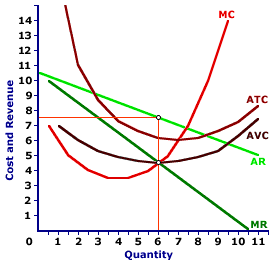
|
|
FDI: The abbreviation for Foreign Direct Investment, this is the acquisition of controlling interest in foreign firms and businesses from one country in another country. FDI can also take the form of constructing factories, structures and equipment (or any form of physical capital) in foreign soil. FDI does not include foreign investment into the stock markets (portfolio investment). Most economists consider foreign direct investment more useful than portfolio investment since this last one is generally regarded as temporal and can leave the foreign country at the first sign of trouble. FDI on the other hand, is considered more durable and with larger economic (potential) benefits.
Visit the GLOSS*arama
|
|


|

|
                           MONOPOLY, EFFICIENCY: A monopoly generally produces less output and chargers a higher price than would be the case for perfect competition. In particular, the price charged by a monopoly is higher than the marginal cost of production, which violates the efficiency condition that price equals marginal cost. Monopoly is inefficient because it has market control and faces a negatively-sloped demand curve. Monopoly does not efficiently allocate resources. In fact, monopoly (if left unregulated) is generally considered the most inefficient of the four market structures. The reason for this inefficiency is found with market control. As the only seller in the market, the negatively-sloped market demand curve is THE demand curve facing the monopoly. If buyers want to buy, they must buy from the monopoly.The negative slope of the demand curve means that the price charged by the monopoly is greater than marginal revenue. As a profit-maximizing firm that equates marginal revenue with marginal cost, the price charged by monopoly is greater than marginal cost. The inequality between price and marginal cost is what makes monopoly inefficient. Profit Maximization| Inefficiency |  |
Consider the production and sale of Amblathan-Plus, the only cure for the deadly (but hypothetical) foot ailment known as amblathanitis. This drug is produced by the noted monopoly firm, Feet-First Pharmaceutical.A typical profit-maximizing output determination using the marginal revenue and marginal cost approach is presented in this diagram. Feet-First Pharmaceutical maximizes profit by producing output that equates marginal revenue and marginal cost, which is 6 ounces of Amblathan-Plus in this example. The corresponding price charged is $7.50. This profit-maximizing production is not efficient. In particular, the price is $7.50, but the marginal cost is only $4.50. Society is producing and consuming a good that it values at $7.50 (the price). However, in so doing, society is using resources that could have produced other goods valued at $4.50 (the marginal OPPORTUNITY cost). Society gives up $4.50 worth of value and receives $7.50. This is a good thing. It is so good, that society should do more. However, the monopoly is not letting this happen. Feet-First Pharmaceutical is not devoting as many resources to the production of Amblathan-Plus as society would like. An Efficient AlternativeThe degree of monopoly inefficiency can be illustrated with a comparison to perfect competition. Such a comparison is easily accomplished by clicking the [Perfect Competition] button. A primary use of perfect competition is to provide a benchmark for the comparison with other market structures, such as monopoly.A comparison between monopoly and perfect competition indicates: - Monopoly produces less output than perfect competition. In this example, monopoly produces 6 ounces of Amblathan-Plus compared to about 7.5 ounces for perfect competition. The Feet-First Pharmaceutical monopoly does not allocate enough resources to the production of Amblathan-Plus.
- Monopoly charges a higher price than perfect competition. In this example, the monopoly price is $7.50 per ounce versus about $6.75 per ounce for perfect competition. The Feet-First Pharmaceutical monopoly is NOT efficient because it produces at a quantity in which price is greater than marginal cost.

Recommended Citation:MONOPOLY, EFFICIENCY, AmosWEB Encyclonomic WEB*pedia, http://www.AmosWEB.com, AmosWEB LLC, 2000-2025. [Accessed: July 18, 2025].
Check Out These Related Terms... | | | | | | | |
Or For A Little Background... | | | | | | | | | | |
And For Further Study... | | | | | | |
Search Again?
Back to the WEB*pedia
|



|

|
BEIGE MUNDORTLE
[What's This?]
Today, you are likely to spend a great deal of time strolling around a discount warehouse buying club hoping to buy either a case for your designer sunglasses or arch supports for your shoes. Be on the lookout for crowded shopping malls.
Your Complete Scope
This isn't me! What am I?
|

|
|
Potato chips were invented in 1853 by a irritated chef repeatedly seeking to appease the hard to please Cornelius Vanderbilt who demanded french fried potatoes that were thinner and crisper than normal.
|

|
|
"A winner is someone who recognizes his God-given talents, works his tail off to develop them into skills, and uses those skills to accomplish his goals. " -- Larry Bird, basketball player
|

|
PDI
Personal Disposable Income
|

|
|
Tell us what you think about AmosWEB. Like what you see? Have suggestions for improvements? Let us know. Click the User Feedback link.
User Feedback
|


|


